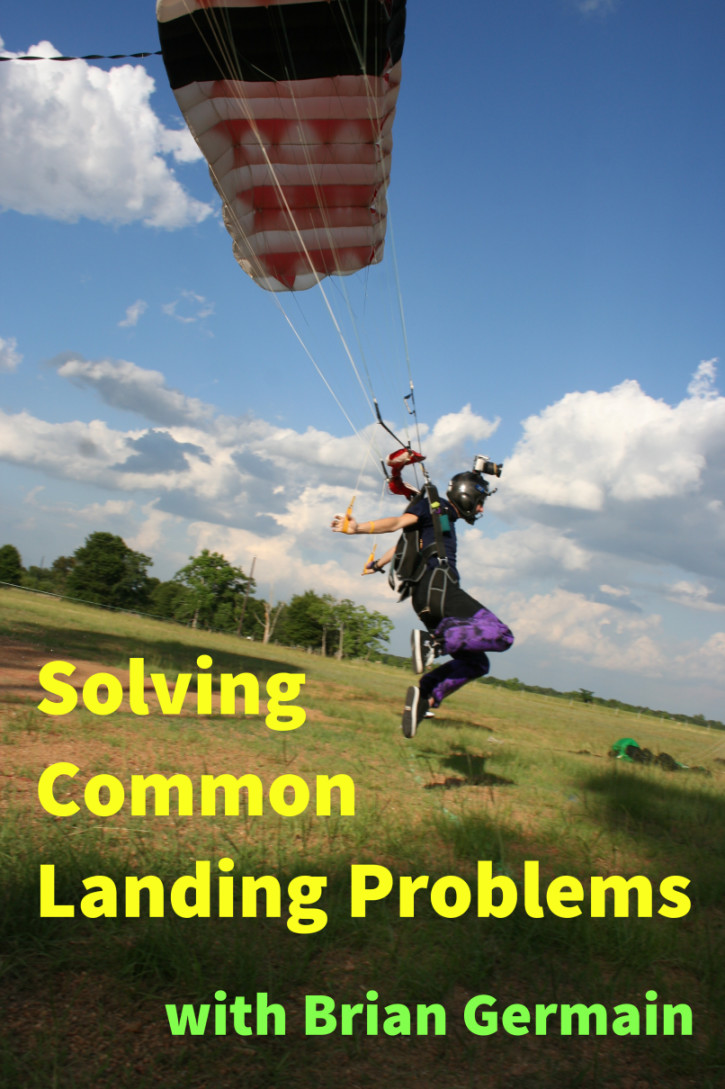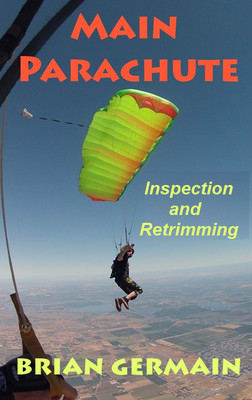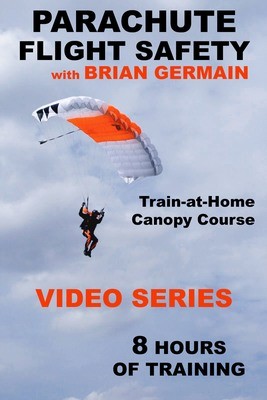
Solving Common Landing Problems
Download and Streaming!
"The video helped improve my landings quite a bit. Brian's approach helped me realize and visualize so many little things and put them all together to create consistently soft and accurate landings. As I was putting it to practice I could literally hear him saying "milk it out" as I was flaring. Great stuff!"
-Isaac Monteagudo
"It is an amazing video! Loved it and learned a ton from it." -Kelly Bee Fox
Despite significant advances in parachute design, landing accidents are on the rise. A perfectly functioning canopy over your head is clearly not enough to prevent twisted ankles, broken bones, and even loss of life. When it comes to safety, knowledge is power. In this fascinating and informative two hour video, Brian Germain guides you on an all-encompassing survey of the topic of landing safety. Originally created for instructors, this in depth seminar is now available to anyone who wants to learn more about what can go wrong on landing, and what we can do about it.
Duration: 2 hours
Format: Streaming and/or Download
Please download the ownership certificate as soon as possible.
*If you delay, the link will expire and you will need to email us with a request for a new ownership certificate.
Hi Mr. Germain,
I recently purchased your video for solving common landing problems, and I wanted to say THANK YOU for the incredibly useful and enjoyable material in it. I'm new to the sport, and I've really struggled with my landings until now. But now, people around the drop zone have noticed and complimented me on the improvement in my landings. Landing has gone from "some rigid formula I have yet to figure out" to me feeling more in-tune with the canopy, the wind conditions, etc. It's a great feeling! I owe you big time!
Thanks again,
Jamie
FULL ARTICLE:
Solving Common Landing Problems
by: Brian Germain
Reprinted from SKYDIVE Mag
Fri, 15 Aug 2014 at 5:50AM
I have been trying to help skydivers to land softer for nearly 30 years, and I love what I do. Something I have come to realize is that almost all of the errors I see are mistakes that I have seen before; often hundreds of times before. This means that if you are beating yourself up for being stuck in a rut at the moment, you can stop it. You are not alone, and your improvement is closer than you think.
The 'Tip-over'
For instance, a very common landing error is what I call the “tip-over”. Most often on a windy day, people will bank wildly at the end of the flare, reaching for the ground with one foot while letting off of the toggle on the other side. This usually results in embarrassment combined with physical pain, often the lasting sort. Both the causes and the solutions to this stereotypical wipe-out are absolutely knowable.
Once you understand the dynamics of what leads to the crash, you are able to turn your full attention to the visualization and the muscle memory of the solution. In this case, it is the loss of airspeed due to the flare itself that begins the drift toward the unwanted future. When combined with a misalignment with the wind, the flare actually increases the sideways motion that cues the sinister music that has the potential to end with screeching tires, children screaming and ambulance sirens. Your fate, however, is not sealed; there is an answer.
Tip-over Solution
When you realize that you are sliding sideways, it is natural to look in the direction you are now traveling. It is the truth. Nobody is going to blame you for looking where you are going. In this case, unfortunately, looking where you are going is likely to exacerbate the situation because when you stare at what you don’t want, you usually get it in spades. You might call it the Law of Attraction, or a self-fulfilling prophesy, but the end result is, by looking toward the current direction of motion, you are unable to execute the solutions. That is, by looking against the grain, back toward the wind-line, you begin unconscious behaviors that cause the canopy to turn back into the wind. Instead of negatively fixating, you are looking in the direction of the answer.
The next phase of the solution to the tip-over is to make your eyes, then your hands, level with the horizon. By returning to balance and symmetry, the parachute recovers to a zero roll angle, allowing for a safe landing. If you still have airspeed, you will now be able to continue the turn into the wind, as you further evolve your flare into a higher and higher angle of attack. Finishing with the parachute directly over your head is the final phase of the landing, bringing the toggles to the lowest position possible without moving backwards. You flare until you run out of arms, or groundspeed, whichever comes first.
Better Landings for All
I love watching people figure this out. Often it is just a little thing that I say, or a drill that I give them to work on at altitude, but when it happens, I remember why I do what I do. My reason for dedicating my life to the pursuit of better landings for all is because I love skydivers, plain and simple. When I see people getting frustrated, slipping into a feeling of helplessness, it really hurts my heart. I know that anyone who wants to land softly can do so, but there is a process of mental and physical evolution that must be undertaken. It takes both time and effort, and the tireless quest of knowledge.
I have written many articles on landing safety, and although I know some of them have been helpful, I also realize that there is a limitation to what can be explained in text alone. So I wrote a big fat book with lots of diagrams. People tell me that it has been helpful. In the end, however, I have come to the conclusion that the best format for truly helping as many people as possible is a multi-media approach; so we went to video.
Video Course
Recently, with the help of my wife Laura, I created a video course entitled 'Solving Common Landing Problems'. It is based on a presentation I have given all over the world, most often to groups of instructors. People seem to really dig it, and I am so pleased to be able to share it on a grander scale. It is my sincere hope that frustrated skydivers and teachers all over the world will download it and begin the change that they have been hoping for. I want everyone to enjoy parachute flight without fear holding back their joy.
Positive Visualisation
The video is two hours in length, and covers the vast majority of errors that I run into over and over again. The video is about problems, but more importantly it is about explanations and answers to these problems. I offer drills and subsequent instruction that can reduce the risk of each error happening again the future. I include landing footage from actual canopy course participants embedded in the in-depth PowerPoint, so as to present lots of clear imagery. I also include a number of positive visualization examples to mentally pave the way to the improved future that I know is certain for those tenacious enough to see this through.
Let Go
I think we did a solid job of putting this one together. Nevertheless, no single source of information can change everything. The best video, the best instructor, and the best parachute need to be met halfway by the one flying the parachute. If you do not let go of the past, and clear a route to a better future with your refreshed belief in yourself, this video cannot help you. We must always remember that the past is merely evidence of a previous paradigm, and it provides you with the motivation to change. If you are ready, 'Solving Common Landing Problems' can help you to expedite your evolution into the best canopy pilot that you can be. Invariably, that is far better than you have thus far envisioned.
BSG



